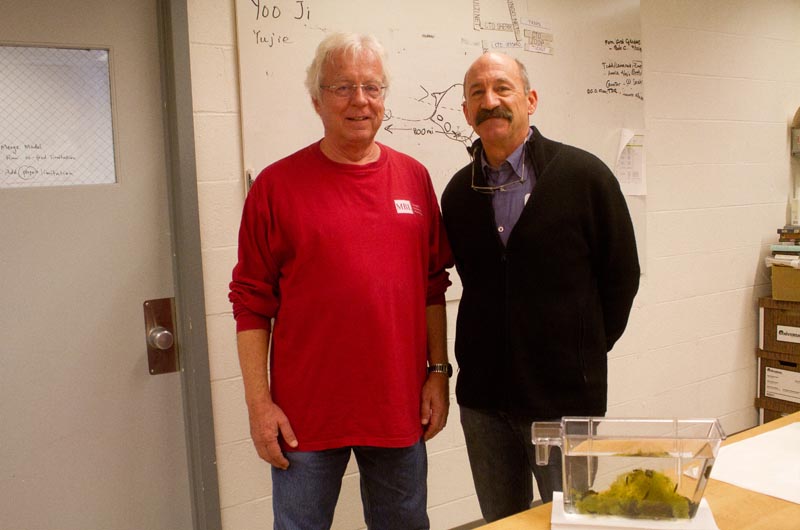Menemsha Pond means different things to different people. For some, it’s a place to sail in the summer, for others a place to go scalloping in the fall.
For Dr. Sidney (Skip) Pierce, a professor emeritus at the University of South Florida, Menemsha Pond is a place where discovery begins. It is the home of Elysia chlorotica, a type of sea slug with remarkable genetic properties. Mr. Pierce has been studying this slug for more than 30 years. Elysia chlorotica is small, averaging about an inch and a quarter in length. It has a lifespan of about 11 months and is euryhaline, meaning it is capable of living in a wide range of salinities (a good thing, in the tidal waters of Menemsha Pond).
Initially, Mr. Pierce started studying the sea slug because of its salinity tolerance. He’d heard of it through a colleague working at the Marine Biological Laboratory in Woods Hole. Its existence had been noted on a marine life survey commissioned by the MBL, but nobody knew much about it. Tiny Elysia chlorotica was “something you’d scrape off the bottom of your boat,” and not think of afterwards, said MBL manager David Remsen.
Mr. Pierce brought research specimens to talks as he explained his developing understanding of the sea slug’s biology. That’s interesting, people would tell him, but look at those things — they’re bright green.
“You should look at that,” Mr. Pierce recalled people saying. So he did.
When Elysia chlorotica is in the sunlight, it spreads its body out and resembles a small green leaf “trying to photosynthesize,” said Phil Alatalo, a research associate at the Woods Hole Oceanographic Institution. Mr. Alatalo has been collecting sea slug specimens for Mr. Pierce since he first started his work on salinity.
The sea slug eats just one type of food: an algae called Vaucheria litorea. It gets immediate nutrients from the plant when it feeds — and then it keeps the chloroplasts alive in its own digestive system, so it, too, can get nutrients from photosynthesis.
“They can incorporate the [chloroplasts] into their body, and they can maintain those chloroplasts, so an animal can act as a plant,” Mr. Alatalo said. “That’s very, very unusual.”
“You’ve got these things that are completely overlooked, but when someone takes the time to learn about their natural histories, it’s more information for humans,” said Mr. Remsen. He cited the work of Virginia Scofield, whose work at the MBL studying tissue rejection in tunicates (a type of marine invertebrate that lives in colonies) led to the discovery of how the HIV virus enters the bloodstream. “They lead complicated little lives,” Mr. Remsen said. And Elysia chlorotica's little life also could have implications for humans. In June, a group of German researchers visited Woods Hole attempting to learn how the sea slug keeps chloroplasts alive. They hope to use the information to help create new treatments for burns, Mr. Remsen said.
Mr. Pierce’s lab in Tampa is currently demonstrating and testing “by every means we can” that the genes from the Vaucheria algae are actually transferred into the sea slug’s genetic material — a type of horizontal gene transfer.
“The slugs have already figured out how to do it,” Mr. Pierce said. “That just shouldn’t work, but it does.”
The process of horizontal gene transfer has also attracted interest from across the globe. Last weekend, a documentary film crew from Japan accompanied Mr. Alatalo on a collecting expedition at Menemsha Pond. The film focuses on evolution.
“It was a great example of how genes get transferred from species to species,” film crew translator Reina Endo told the Gazette in an e-mail. The film crew has shot across the United States, as well as in Poland, Switzerland, Spain, China, Australia and Belgium. They spent five days in Woods Hole, shooting the collection process as well as time lapses of the slug in its native habitat.
There are other types of slugs with the chloroplast adaptation, Mr. Pierce said, including one that is found in the Florida Keys, but Elysia chlorotica does it the best.
And while the sea slug lives in other places on the Eastern seaboard, it has never been found anywhere with the same consistency as Menemsha Pond.
“I don’t know what it is about that marsh,” Mr. Pierce said. There have only been two periods since he started his research when the sea slug disappeared. One was after Hurricane Bob ripped through the area, moving sand across Lobsterville Beach and into the pond.
“They were gone for two years,” Mr. Pierce said. “I thought we were done.”
Mr. Alatalo said that Menemsha Pond has very little nitrogen pollution, a factor that he posits affects the algae food source more than the sea slugs themselves.
While out with the film crew, Mr. Alatalo collected about 150 specimens, which would be put in Ziploc baggies and shipped overnight to Mr. Pierce’s lab in Tampa.
“They do just fine,” he said.





Comments (1)
Comments
Comment policy »